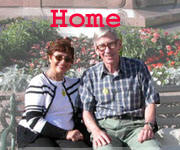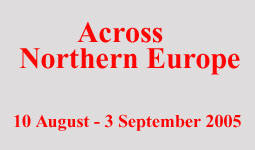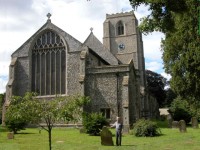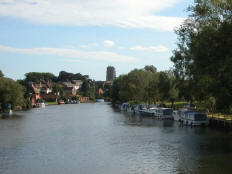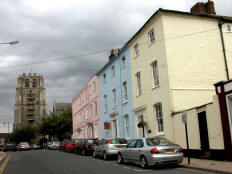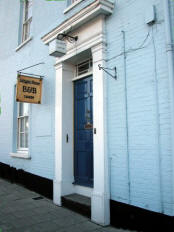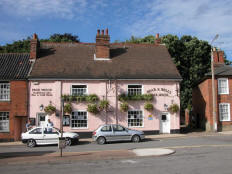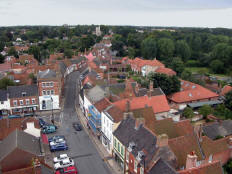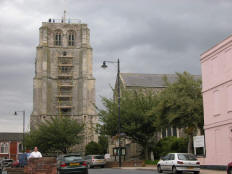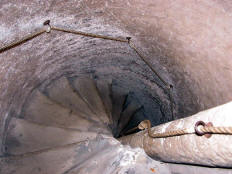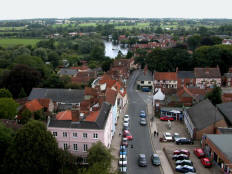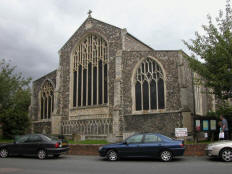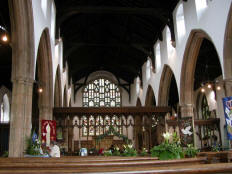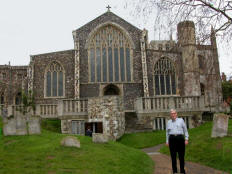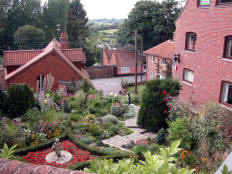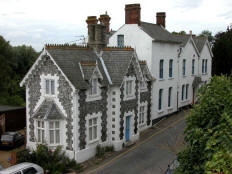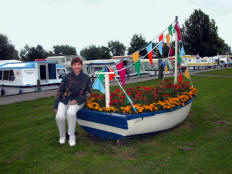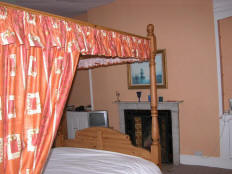Part III - Page 13 14 Go to: Part I Part II Part IV PART III Ancestral Sites in East Anglia [Note: Although this Part III describes some beautiful small communities, it also includes considerable genealogical information.]
Saturday, 27 August. The taxi took us from the dock in Dover to the nearby National Car Rental office. (We had booked the car through Kemel, which arranges for cars from other companies.) We were on the road by 9:30, but we didn’t get far. Within the first half mile I made a wrong turn at a roundabout, ended up in a parking lot that seemed to have no exit, and had to ask directions. No automatic transmissions had been available, and I worried about shifting with my left hand, but that turned out not to be a problem. Neither did driving on the “wrong” side of the road, though I had to be very careful in roundabouts and when making turns. One problem I did have, though, was that I tended to stay too far to the left and occasionally hit the curb. We were headed for East Anglia and, since Dover is also well east of London, our plan was to stay well east of the city to avoid traffic. I had detailed direction from the Internet, but they turned out to be too detailed and therefore hard to follow. We missed a turn somewhere and missed the most easterly Thames River tunnel. We found the next tunnel, but the error cost us an extra 23 miles and took us through heavier traffic.
The motorways (expressways) were quite fast but, once we left them, the roads were two-lane with slow traffic. Then once we got to Beccles, we had trouble finding the Saltgate House, our B&B. Beccles was a far cry from the quiet country village we expected. It is situated on the south bank of the Wavenly River, the boundary between Suffolk and Norfolk, and at least 100 pleasure boats are moored in the town. Since it was Saturday, the town was swarming with weekend visitors, making it difficult to stop anywhere on the narrow streets to figure out directions. Beccles is an ancient town, first mentioned in historical records in 936. At that time it was a fishing village on a wide salt water estuary. But the estuary eventually silted up, finally allowing the Wavenly River to be confined by banks and the adjacent lands to be reclaimed. Saltgate, the street on which our B&B was located, once led to the water’s edge. After the river was confined, the area to its north, now Northgate (street), was filled in and built up with houses and shops.
My first-known Peck ancestor, Robert Peck (the elder, born before 1500) left nearby South Elmham St. James in 1525 and moved to Beccles, where he was was married (twice), had seven children, and finally died in 1556. His son, Robert (the younger, 1546-1598), was born, married, and died in Beccles, leaving seven children. The youngest of these was my ancestor, Joseph (1587-1663), who moved first to Hingham (Norfolk County), then to America. Our B&B was located at #5 Saltgate. We saw the street once as we drove by but, because of the many one-way streets, we just couldn’t find our way back to it. I finally got out of the car and found it on foot. By the time we got checked in, it was 1:45 and we were starved. We had lunch at the Bear & Bells pub (technically a "freehouse") on the old square a few steps from the B&B.
Then while Jane rested, I went out to get my bearings. It turned out the town was very easy to navigate once you learned the basic layout. I walked up Saltgate past old St. Michael’s Church where the road split. I went through Newmarket (square) and followed Ballygate (street) toward the Beccles and District Museum. Ballygate itself was of particular interest to me because my ancestor, Robert Peck the younger (1546-1598), lived on that street and owned at least two rental properties there. I soon found the Museum, located in the Lehman House (built before 1576, restored 1762). Unfortunately, there were no items or exhibits dating back as far as the time my ancestors lived in Beccles (1525-1614). I spoke to the resident expert on old Beccles, but she could add nothing on that period either, except that there were still a few buildings dating to that time, including some on Saltgate and its extension, Northgate. On the way back to the B&B, I saw that the tower of St. Michael’s Church was open and went in. I climbed to the top on the narrow stone stairs. The view was magnificent in all directions. The tower is detached from the church. The church dates from about 1369, but has been modified considerably over the centuries. Construction of the massive tower (97 feet high) began in 1500 and took 40 years. So both were there when my ancestors lived in Beccles.
When I got back to the B&B, Jane was ready to see the town. We walked to St. Michael’s Church and, on entering, found a Flower Festival in progress. The church itself was beautiful and the many flowers made it even more so. We noticed that refreshments were available in the undercroft and made our way down the stairs for tea and cookies and a chat with the ladies serving it. Afterward we walked behind the church where the graveyard is located. At least six of my ancestors were buried there by 1614 but, of course, there was no sign of their graves.
To make it easier for Jane to see the town without having to walk a lot, I went back for the car. By then it had become cloudy and windy. We drove down Ballygate and all around the old town south of the B&B. Finally we drove up Northgate to the Quay, the park area with a large marina off the Wavenly River. We parked there and explored the Quay on foot. By now a few drops of rain were falling and we decided to call it a day.
When we got back to Saltgate house, we talked for a while with the owners, a couple that had only recently purchased the property. The man gave me a couple excellent maps of Beccles and loaned me a very detailed map of the immediate area, including South Elmham St. James which we hoped to visit the next day. I also expressed my interest in a framed paper on the wall that contained a summary of the old real estate records for the building that housed the B&B. He very graciously offered to make me a copy of it. While Jane rested, I poured over the maps and the summary of real estate records. On its web site, Saltgate was represented as dating from the 16th century. The first entry in the extract of the land records was 1593 when the “house & grounds” there were owned by Richard Flatman. As is common in deeds and land records, the entry listed various previous owners as a way of better identifying the property referred to. I was startled, though, by later entries (1639, 1682) that referred to “Flatman & Peck” as prior owners. Robert Peck the younger, my ancestor who owned considerable property in Beccles, died in 1598. This raised the possibility that we were staying in a property once owned by that ancestor. We went out for dinner at 7:45. There were a couple Indian restaurants, and we tried the Bombay House. The food was good but very spicy. I was starting to get a cold, and I think the spices stopped it in its tracks. We got back to the B&B about 9:00 and went to bed at 10:30.
Our room was the Saltgate House’s best, or at least the most expensive. It was the only room with a four-poster bed. It faced the street, though, rather than the quiet garden in the rear. We thought we might have trouble sleeping because the street was very noisy (racing cars, motorbikes, and people shouting). Also, the window shades were not the light-blocking kind, and there was a well-lit petrol station/garage directly across the street. (The old buildings there had been torn down before the dawn of the preservation movement.) In spite of it all, though, we slept very well.
Part III - Page 13 14 Go to: Part I Part II Part IV |
